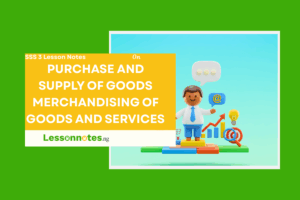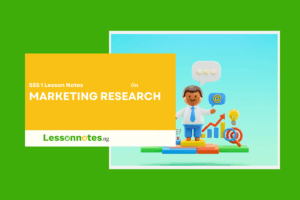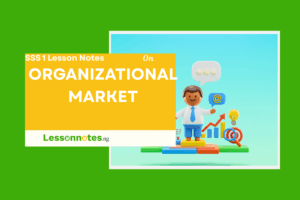Organizational Buying Behaviour SS1 Marketing Lesson Note
Download Lesson NoteTopic: Organizational Buying Behaviour
Organization buying is the decision-making process by which formal organizations establish the need for purchased products and services and identify, evaluate and choose among alternative brands and suppliers.
Some of the characteristics of organizational buyers are:
- The consumer market is a huge market of millions of consumers where organizational buyers are limited in number for most of the products.
- The purchases are in large quantities.
- Close relationships and service are required.
- Demand is derived from the production and sales of buyers.
- Demand fluctuations are high as purchases from business buyers magnify fluctuation in demand for their products.
- The organizational buyers are trained professionals in purchasing.
- Several persons in organizations influence purchase.
- A lot of buying occurs in direct dealing with the manufacturer.
FACTORS THAT INFLUENCE ORGANIZATIONAL BUYING BEHAVIOR
Organizational buying is much more complex than consumer buying and thus deserves to be studied separately. The entwined interpersonal relationships and the multiple communication processes between the organizational members involved in the buying decision process are some of the major contributors to this complexity. The list of affecting factors is not limited to these; there are many more important ones such as:
- EXTERNAL ENVIRONMENTAL FACTOR: As a major constraint under which a business operates, the external environment impacts nearly every aspect of a business, including its buying decisions. Here is a list of the external elements that affect organizational buying.
(a) Economic conditions: The fluctuations in the money markets and the interest rates have a major impact on the buying strategies. The interest rates and organizational buying have an inverse relation; in most cases, an increase in the interest rates may bring about a drop in buying.
b) Regulatory changes: Any changes in the corporate laws, rules and regulations will also influence how, when and what the organizations buy. There are also regulatory changes that may affect only a particular industry and accordingly, the related organizations will change their buying patterns to stay in line with the new regulations.
(c) Political environment: A change of the government or policy has a direct impact on the economic scenario, and this ultimately translates into a shift in the organizational buying patterns as well.
(d) Social environment: Societies and cultures are ever-evolving, and every business has to change its practices and procedures to meet up with societal changes. For instance, with the rise in the number of animal lovers, pure leather suppliers have seen a slump in their business. The clothing and footwear manufacturers have shifted to artificial leather suppliers. This points out how the social environment can affect the buying patterns of organizations.
(e) Competition: Today’s business is all about beating competition and staying ahead. So, when an organization’s competitors move on to a newer product or service, or if they get to enjoy a competitive edge because of their suppliers, it is very likely for the organization to change its trend and thus, its buying pattern will change accordingly.
INTERNAL ORGANIZATIONAL FACTORS
More than the external factors, it is the internal organizational factors that influence the Organizational buying. These internal factors are:
a) Organization’s goal and objectives: The goals and objectives of an organization are major determinants of how and what the organization will purchase. An organization that wants to capture a bigger chunk of the market by selling cheaper stuff is more likely to look for suppliers who can supply larger quantities at a low price.
However, a company whose goal is to deliver quality products may have a very contrasting buying pattern, and they will focus more on the quality issues than on the price advantage.
b) Organizational structure: Hierarchical and management structures vary from one organization to another. While some organizations have a well-established purchase department, others may assign this job to the HR or Administration department. There are also organizations where the purchase decisions must be taken collectively by all concerned departments.
Organizations also have well-defined guidelines as to which purchase decisions can be made and by which management level. The internal set-up and how authority and responsibility flow through it, play an important role in organizational purchasing.
c) Policies and procedures: How the purchase order is routed depends on the organization’s policies. How the buying procedure begins, who will participate and who has the ultimate authority to decide on the purchase are all dependent on the policies and procedures of the organization.
Some organizations prefer to invite public bids, while others may contact only a few suppliers on their list. There are also budgetary policies that have a say in the purchase decisions. For instance, while some organizations may have a flexible policy to make purchases as and when the need arises, others may have to wait till the allocation of the annual or biennial budget.
d) Technological levels: Whenever new purchases are made, organizations take into consideration their current technology. Some purchases are meant to replace the current technology with a newer version, so their buying decision will be influenced by what level of technology they currently own. Also, organizations try to ensure that all new purchases being made are technologically compatible with their existing technology. So, one way or the other, an organization’s existing technology has a major influence on its future purchases.
e) Manpower skills: Whether the organization has the skilled manpower to make proper and optimum use of the new purchases being made, especially equipment and machinery, is another issue that influences organizational buying.
INTERPERSONAL AND INDIVIDUAL FACTORS
Since organizational buying decisions are never a one-person affair, interpersonal relationships with the decision-makers play a vital role in the type of buying.
a) Participation And Authority: In organizational buying situations, there are always re-defined rules as to who can participate in the purchase decision and who is the ultimate deciding authority.
b) Interpersonal Conflict: Interpersonal conflicts and conflicts of interest among the decision-makers often result in delays and changes. Thus, the kind of thinking and the kind of relationship the decision-makers share have a major role to play in corporate buying.
c) Education And Awareness: The educational background of the decision makers and their level of awareness have a major bearing on what type of purchases they will make.
d) Risk-Taking Ability: If the buying committee constitutes high-risk takers, they will not be averse to the idea of choosing the latest technology or new suppliers. On the other hand, decision-makers with low risk-taking tolerance are more likely to stick to proven and tested technology or to well-known and well-established suppliers.
e) Individual Factors: Individual factors such as age, cultural background and social status of the members of the buying team, also influence the buying decisions.





















